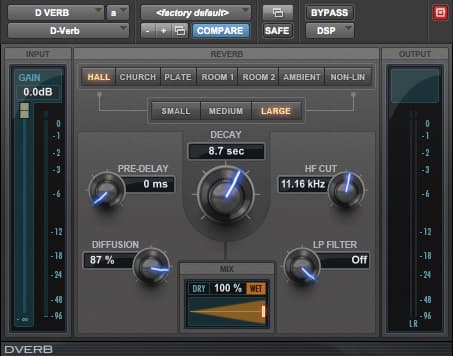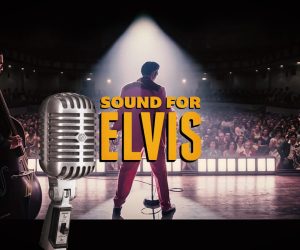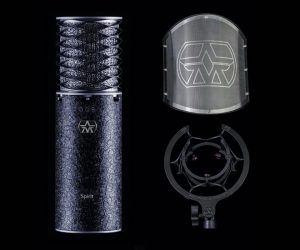
Jamie xx Hits the Spot
The planets align for Jamie xx & Tom Elmhirst, who play the percentages of digital and analogue to lend gravity to In Colour.

Artist: Jamie xx
Album: In Colour
“There’s no fat with his music,” is how mixer Tom Elmhirst would sum up the In Colour multi-tracks Jamie Smith (aka Jamie xx from The xx) handed to him to mix. “I’m not going to lie,” he said multiple times. “He’s done alright without guys like me around. It was 97 to 98% there. He’s so above average, and I mean that as a massive compliment. What he does on a laptop and a pair of headphones is not available to all of us.”
Elmhirst first heard the now 26-year old Jamie, when The xx were performing one of their first shows, back in the day when they were still a four-piece — “18 and shitting themselves,” remembered Elmhirst. “They hid behind loads of dry ice. I’ll never forget running over to Richard during their set saying, ‘Why the f**k have you not played this to me?’” That’s Richard Russell, head of XL records and an old friend of Elmhirst’s. “It was brilliant even then!”
While Elmhirst hasn’t gravitated towards mixing a lot of club music over his career, he practically cut his teeth on the genre. He started out at Sarm Studios in the Whitechapel area of London, where Queen recorded Bohemian Rhapsody. And in the late ’80s, Ministry of Sound, down on the corner of Elephant and Castle, was dominating the nightclub scene. “All the American guys would play Ministry and do remixes at Sarm East while they were there for the weekend,” said Elmhirst. “They’d start quite late in the day, do a remix, then go straight to Ministry. My very first sessions in the studio were with these amazing American house guys — Masters at Work, Derrick May, Kevin Saunderson — who came because we had custom Eastlake speakers, an SSL, and a really special sounding studio. We’d do remixes on an MPC, E-Mu SP-1200, and a multi-track. It was amazing.”
Growing up in Ladbroke Grove, he also experienced a lot of West Indian culture that permeated London’s music scene, and the prominence of steel pan in Jamie’s music sends Elmhirst right back to the Notting Hill Carnival. “The steel pan was all around us, but what he did with it was very different,” reckons Elmhirst. “Jamie’s a melodist. He stumbled across the steel pan and did something quite different with it. He took it and kind of made it his own, in the way Ron Burgundy made the jazz flute his own, or like Stevie Wonder and a clav.”
NOT THAT NEW HERE
It was actually Jamie’s work with Gil Scott-Heron — remixing the album I’m New Here Heron had recorded with Richard Russell into We’re New Here — that really showcased his production chops. Up until that point, he’d released a few remixes, and everyone had an inkling that much of The xx’s powerfully minimalist execution had a lot to do with Jamie. But being able to compare an entire album’s worth of original music with his remixes quantified the extent of his influence. It was a lot.
He’s now a sought after producer, lending a reverberant house piano and signature xx guitar line to Drake’s Take Care, and bringing an enchanting filtered ambience to his co-production of Alicia Keys’ When It’s All Over. He could have easily cashed in on those credits, but instead shifted his efforts into finishing In Colour. Some of the tracks, The Rest Is Noise in particular, were in the works for a long time and really needed to get over the line. “I worked on that song for about five years,” explained Jamie. “Which is why it goes on such a journey.” It’s a reason so many great records have come out of the XL stable, as Elmhirst explains: “Richard likes people. So when he likes you, he’s going to trust you. He’s not dealing with the weaklings; they’ve got a point, and he just lets them get on with it. He thinks they’re the best taste makers for themselves. That’s really empowering for an artist.”
For Jamie, it was about having the space to finish the album on his own terms, without that pressure of other jobs. “They’re not really worrying about trying to get me to do stuff,” he said of XL. “It’s more trying to finish stuff.”
HUMAN TOUCH
Jamie’s studio in London is constantly evolving to suit his needs. “I did have a console for a while but I prefer to use preamps straight into the Apogee Symphony.” It’s not devoid of analogue gear, the “vocals for Loud Places and See Saw were recorded at my place in London,” he said. “I always use a Neumann U87 with Neve preamps.” He has a handful of compressors he uses to manipulate sounds out of the box, and among some effects units, a hi-fi spring reverb add-on unit from the ’70s. “It’s a separate unit you can rewire to use as an outboard piece,” he explained. “It helps give a little bit of life to certain things.” It’s not about hanging on to any one piece of gear but gathering the things that inspire his creative juices. Sometimes that means going back to the most basic of instruments. “I find it easiest to play the piano, because that’s what I know how to play best,” he said. “I just play until I make something that sounds new to me, that’s different, and has a harmonic to it that gets you every time.”
In Colour eschews the sometimes unholy cleanliness of electronic records for a more organic sound, tailoring the top end and emphasising the lows. Music that lifts its inspiration from vintage samples, even amongst recent proponents of Garage House, can often treat the process as a ‘one and done’ affair. Either bedding samples into a disparate ambience that leaves them poking out to carry ‘the vibe’, or burying them into the mix as token colour. Jamie does neither. By ensuring his productions are organic in their own right, he gives samples a new place to exist that feels neither foreign nor nostalgic. “Though a lot of the stuff I use is electronic, I didn’t want it to sound too clean; I want it to sound human, and almost live in a way,” said Jamie. “It’s a little about how I’m treating sound, but it’s also about making things less rigid than they would be if I’d just left them as they were. The synth on The Rest Is Noise has been side-chained and re-side-chained several times through different compressors at different levels. It’s side-chained to the kick at several different points, and it creates these little peaks that change throughout the track, because most of the kicks weren’t quite on. It makes it sound really different to how it would sound if it was just done in the box, compared to using an actual compressor.
“Things happen quite naturally. Most stuff I’m happy with just flows out and ends up sounding good because I’m happy.”
He offers up Gosh as an example of working on a track till he finds the right feel. “It originally started out at 150bpm, but ended up sounding like a jungle track and didn’t have anything special about it. Then I used Varispeed on Logic, and slowed it down to 143bpm. It gave the whole tune a lot more space, and felt very analogue, but was still just in the box.”
Elmhirst cottoned on to Jamie’s organic style from that first The xx performance: “He curates the sound, and it’s performed. He plays a drum machine into a sequencer, he doesn’t let the sequencer govern him. From a production standpoint, he was quick to understand how he wanted electronic music to sound — and that was, it should sound performed.”
He was quick to understand how he wanted electronic music to sound — and that was, it should sound performed

He took it and kind of made it his own, in the way Ron Burgundy made the jazz flute his own, or like Stevie Wonder and a clav
IN THE PERCENTAGES
This was the first time Jamie has turned his album over to a top-flight mixer with such a wealth of analogue gear. Similarly new for Elmhirst, in a career that’s spanned a couple of decades, the In Colour session was one of a handful where he had the artist in attendance for the entire duration. He doesn’t think mixing is a “spectator sport”, preferring to just work with his assistant, Joe Visciano. “I find many artists have a better perspective when they come in later in the day and the mix is quite close.” But having Jamie in the room wasn’t exactly distracting, Elmhirst pointed out: “He’s a man of few words. So when we did talk, it was quite quick and to the point. He’s super quick to go, ‘nah, I don’t like that.’ We mixed that whole album in six or seven days.”
When Elmhirst spread the entire mix across his Neve VR console at Electric Lady Studio C, he was searching for that last few percent to bring to the songs. “I added a little bit of dimension and width, the depth of field which I don’t think you get from a laptop.” said Elmhirst. “And some analogue processing.” It’s Elmhirst’s ability to be so frank about his involvement level that makes him such a powerful ally. While he reckons his contributions to a mix might typically add 30-40%, he’s not automatically looking to stamp his imprint onto a record if it doesn’t need it. Even the small percentages he did bring were made to order. “It was a case of, ‘What do you want to do? Go wider, deeper?’,” said Elmhirst. “I think he enjoyed sitting at the back of a room and listening.” Every now and again, Jamie would ask to listen to it on headphones, recalled Elmhirst, which was usually a sign he was happy with the mix. “Usually what works in headphones will work in a club,” reckons Jamie.
It was that dual outcome Elmhirst had to keep in mind: “Jamie wants it to be a) listenable at home or in your car, but b) also wants it to pound in a club.” To meet that second criteria, he often deferred to Jamie’s judgement. “Jamie is much more in tune with club culture,” said Elmhirst. “So sometimes the vocals aren’t going to be the most important thing. Loud Places is not that loud if you listen to it. She’s not on top, it’s very much part of the fabric of the track. Not where I’d put an Adele vocal. I’d want to turn her up, but Jamie would be, ‘nah, nah, she can be inside it.’ That’s the fun process of making records. You allow everyone to do their bit, and you collaborate, and it all works out in the end.”
Halfway through mixing the album, they hired a club in Brooklyn and invited a bunch of friends down so Jamie could play the record in amongst a DJ set. “It’s such an important part of mixing club music,” reckons Elmhirst. “To road test it right there and then. It’s like being a chef. It’s very quick from A to B. If something doesn’t feel right, you know straight away. Jamie did come back with some changes after that.”
It’s about finding “that communal moment, like being at church, when certain things make sense and you get to share them with a bunch of other people,” said Elmhirst.
CONDENSING THE WETNESS
The lack of any fat in the multi-tracks was the best starting point for Elmhirst’s mix. After all, he said, “all we’re doing when we’re mixing records is trying to condense an idea. If you start with 40 tracks, it goes to 10, then left/right stereo. It’s a constant state of reduction.”
Some of the tracks were sparse in their own right. Stranger In A Room, for instance, was just two stereo synth/guitar tracks and a vocal.
Jamie says he tries to “use as few instruments as possible to make the sound I want to make.” His main synth, an Oberheim 8-voice, fits that bill perfectly. “It’s like eight different synths just piled up on top of each other, and takes forever to make something on,” he says. The piling on of voices into the one patch making it “feel like a don’t really need any other synth.”
Although it wouldn’t seem like it, songs like Stranger In A Room are probably where Elmhirst can have his biggest impact. Vocals are really important to him. “I did a lot on that in terms of keeping Olly’s vocal in-your-face. The vocal sounds like he’s sort of talking to you in your ear. But there’s actually a whole bunch of stuff going around behind him, it’s just not in the forefront.
“There might be seven or eight effects on the vocal, but you can’t pinpoint one. You can’t go, it’s Preset 44 on a Lexicon PCM80, because I’d rather shoot myself in the head. I might use seven reverbs on one vocal, but they’re all doing very different things, and all EQ’d differently. I’m not a huge fan of high end on a vocal reverb, I don’t like when an ‘s’ goes ‘tsss’. In the old days we used to use an SPX90. And there was a preset, I think it was 23, called Pitch Change C. It was like having NS10s in the studio, you had to use it on the vocal. But I’d rather use eight effects incrementally working together.
“I use quite a lot of Lexicon Delta-T, which was a box used to offset speaker stacks in stadiums. The maximum delay time is 122ms, it’s hybrid digital/analogue, but it’s a very warm delay. I use a slight offset left and right delay, quite short; 90ms on one side, and 100ms on the other. I also use a bit of chorus, I really like the Roland CE-1 chorus pedal that tragic guitarists used in the ’70s. But you couldn’t necessarily pick it if you sat there listening to the vocals.”
Jamie also uses other effects to give a sense of depth. Particularly, he likes using “a phaser effect to place something in the mix. But using it to put it in one place, rather than having it phasing and moving about.”
Every little nuance contributes to the organic sense of depth and width, even that last two or three per cent, said Elmhirst: “If everything’s loud all the time, there’s no dynamics. If everything’s dry, there’s no background. If everything’s wet, there’s no foreground. That’s the interesting thing about mixing records.
“Jamie likes quite short rooms. I like when the vocal is quite present and in-your-face, but there can be things behind it. It’s all about placement, where you put instruments and vocals to create space. The way I work, which is still on an analogue console, I have sends on the vocals. And I can alter in an arrangement — between verse and chorus — how much is wet, dry, delayed, reverb.
“It’s the same in film, where some directors will use music or visual prompts to provoke a reaction, while some will use the inverse. Silence where there should be grand orchestration, and close shots in a big space.”





Before sending the lead vocal out to the effects, Tom treated it with some standard de-essing, before adding some harmonic juice with the Massey Tape Head and Soundtoys Decapitator plug-ins, then finally using another de-esser at the end of the chain to tame the really high end.


You can also see how Tom rolled off the Synth Hi track above 4kHz, in keeping with Jamie’s organic sound, and used the UAD Fairchild 660 plug-in to compress the simple guitar line. The entire mix is simple, and a lesson in restraint, letting the vocal take the lead.
COSMIC COINCIDENCE
The connection between film and mixing isn’t just philosophical for Elmhirst. He always plays visuals on the big screen while he’s mixing. When he mixed the Arcade Fire album, it was weeks straight of Kill Bill; “there’s a balletic quality to martial arts that lends itself to the precision of making records.” Other times, he’ll have nature reels like Planet Earth on loop in the background.
“To me, records should be very dimensional like that,” he said. “It’s not just left and right, it’s like film — foreground, background. It’s focus, vertical dimension, and width. Why can’t they inform each other?”
Despite painting himself out of the picture. One thing Elmhirst will take credit for is the inspiration for Gosh’s music video. Which is an epic animation directed by digital artist Erik Wernquist about a future terra-formed planet that looks a lot like Earth on its far side.
In perfect cosmic alignment, while he was mixing In Colour, he had Alfonso Cuarón’s Gravity playing for the entire time. So enthralled is he by director Cuarón’s recreation of microgravity and the Light Box/robot-controlled camera combination used to technically execute the film, when I talked to him months after Jamie had left, it was still onscreen at Electric Lady.
“The film was groundbreaking on a technical level,” enthused Elmhirst. “It makes creating a record look so simple. They built a light chamber with LED panels, and then put this rocking horse thing in the middle so the actors could rotate, while robots that are use in car manufacturing manoeuvered the cameras.
“It relates to mixing, because in mixing, you have such a long learning curve, to understand compression, limiting, EQ, balance. And then you have to forget it all. It’s like learning to ride a bike. Once you know how to ride a bike, you don’t remember how you learnt, you just ride it.
“I spent 10 years learning how to do this, and now I just try and concentrate on song, melody, lyric, artist. Going back to Gravity, what’s brilliant, is it’s so staggeringly technical, but when you watch it, it’s just a story about human evolution, pain, loss, life, love — all the standard jazz. For it to be technical, but emotional and emotive, and a story about human pain, love and loss is brilliant.
“I think In Colour achieves a similar objective. But seen through Jamie’s eyes and his experiences with London club culture.
“There’s a galactic, yet universal quality to that record — it’s very soulful.”
















RESPONSES